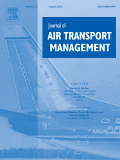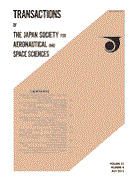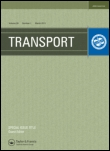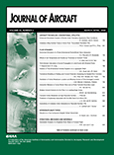
International Journal of Aviation Aeronautics and Aerospace
Scope & Guideline
Unleashing Potential in Aeronautics and Aerospace Research
Introduction
Aims and Scopes
- Aviation Safety and Management:
Research focusing on safety management systems (SMS), risk management practices, and the cultural factors influencing safety in aviation operations. - Technological Innovations in Aviation:
Studies exploring the impact of advanced technologies such as artificial intelligence, virtual reality, and unmanned aircraft systems (UAS) on aviation operations and training. - Sustainability and Environmental Impact:
Investigations into the environmental implications of aviation practices, including fuel efficiency, sustainability initiatives, and the regulatory landscape affecting aviation. - Pilot and Crew Training and Performance:
Research on training methodologies, performance metrics, and psychological factors affecting pilots and crew members, including the use of simulation and augmented reality. - Air Transportation Economics and Policy:
Analyses of economic factors, policy implications, and the operational efficiency of aviation systems, including airport development and airspace management. - Human Factors and Ergonomics:
Explorations of human factors affecting aviation, including communication styles, stress management, and the impact of design on user experience. - Space Exploration and Technology:
Research focusing on aerospace innovations, including space travel, satellite technology, and the integration of new systems in aerospace operations.
Trending and Emerging
- Counter-Uncrewed Aerial Systems (UAS) Research:
A notable increase in research surrounding counter-UAS technologies and strategies reflects the growing concerns regarding security, privacy, and the integration of drones into airspace. - Integration of Artificial Intelligence in Aviation:
The application of AI in various aspects of aviation, from operational efficiencies to pilot training, is a rapidly growing area of interest, indicating the industry's shift towards automation and smart technologies. - Virtual and Augmented Reality Applications:
The use of virtual and augmented reality for training, simulation, and operational support is becoming increasingly popular, highlighting its potential to enhance learning and decision-making in aviation. - Sustainability and Green Aviation Initiatives:
Research focusing on sustainable practices, including alternative fuels and eco-friendly operational strategies, is gaining momentum as the aviation industry seeks to reduce its environmental footprint. - Human Factors and Crew Resource Management:
There is a growing emphasis on understanding human factors in aviation, particularly how communication, decision-making, and psychological well-being impact safety and performance. - Advanced Air Mobility and Urban Air Transport:
Emerging studies on urban air mobility concepts, including eVTOL (electric vertical takeoff and landing) aircraft, indicate a shift towards innovative transportation solutions in urban environments.
Declining or Waning
- Historical Analysis in Aviation Studies:
While historical research has been a part of aviation literature, recent trends indicate a shift towards more contemporary analyses and empirical studies, leading to fewer historical analyses being published. - Traditional Flight Training Methods:
As technology advances, there is a noticeable decline in research focused solely on traditional flight training methods, with a greater emphasis on modern simulation and virtual training techniques. - Basic Aerodynamics Research:
There seems to be a reduced emphasis on foundational aerodynamics research, as more studies are now exploring complex systems and integrated approaches rather than isolated aerodynamic principles. - Regulatory Compliance Studies:
Research dedicated to regulatory compliance in aviation appears to be decreasing, possibly due to a shift towards more innovative and operational aspects of aviation rather than compliance-focused studies. - General Aviation Topics:
Topics specifically related to general aviation are becoming less prominent, as the journal's focus shifts towards commercial aviation, unmanned systems, and advanced aerospace technologies.
Similar Journals

AIRCRAFT ENGINEERING AND AEROSPACE TECHNOLOGY
Bridging theory and practice in aerospace technology.AIRCRAFT ENGINEERING AND AEROSPACE TECHNOLOGY, published by Emerald Group Publishing Ltd, is a leading peer-reviewed journal dedicated to advancing the fields of aerospace engineering and technology. With a strong emphasis on innovative research, the journal aims to bridge theoretical developments and practical applications within the aerospace sector. Although the journal does not currently offer open access, it continues to enrich the academic community's understanding of aircraft design, maintenance, and engineering processes, making it a crucial resource for researchers, professionals, and students alike. By fostering a rigorous dialogue among experts, AIRCRAFT ENGINEERING AND AEROSPACE TECHNOLOGY ensures the dissemination of cutting-edge findings and promotes sustainable practices in the aerospace industry, highlighted by its commitment to high-quality scholarship.

Aerospace Research in Bulgaria
Exploring the frontiers of aerospace technology.Aerospace Research in Bulgaria is a prestigious academic journal dedicated to advancing the field of aerospace engineering and technology. Published by the BULGARIAN ACADEMY OF SCIENCES, SPACE RESEARCH & TECHNOLOGY INSTITUTE (SRTI-BAS), this journal serves as a key platform for researchers, engineers, and professionals seeking to share original research, innovative technologies, and critical reviews related to aerospace applications. With the ISSN 1313-0927 and E-ISSN 2367-9522, the journal aims to contribute significantly to the global aerospace community. Although the journal operates under a traditional access model, it emphasizes the importance of research collaboration and disseminating knowledge in the ever-evolving aerospace sector. The editorial team is committed to maintaining high standards in peer review, making it an essential resource for academics and practitioners alike. Located at ACAD. GEORGI BONCHEV STR., SOFIA 1113, BULGARIA, this journal not only highlights Bulgarian contributions to aerospace research but also aims to engage with a broader international audience, fostering advances that propel the industry forward.

Space: Science & Technology
Pioneering Research for Tomorrow's Space ChallengesSpace: Science & Technology is a premier, open-access journal published by the American Association for the Advancement of Science, dedicated to advancing knowledge in the rapidly evolving fields of aerospace engineering and space sciences. Since its inception in 2021, the journal has rapidly established itself as a vital resource, achieving an impressive Q1 ranking in Aerospace Engineering and Q2 ranking in Space and Planetary Science as of 2023. With a Scopus rank placing it 45th out of 153 in Aerospace Engineering and 47th out of 104 in Space and Planetary Science, it serves as a critical platform for researchers, engineers, and students alike to disseminate their findings and engage with the latest developments in their field. The journal encourages innovative research articles, technical notes, and reviews that push the boundaries of what's possible in space exploration and technology. With its commitment to open access since 2021, Space: Science & Technology ensures that pioneering research is readily available to a global audience, promoting collaboration and knowledge sharing in an increasingly interconnected scientific community.

AEROSPACE AMERICA
Unveiling the Dynamics of Aerospace ProgressAerospace America, published by the American Institute of Aeronautics and Astronautics, stands as a crucial platform within the field of aerospace engineering. With over 30 years of dedication to advancing aerospace knowledge, the journal provides a comprehensive exploration of topics ranging from cutting-edge aerospace technology to aviation policy and industry developments. While it currently resides in the fourth quartile of the Scopus rankings for aerospace engineering, the journal aims to enhance its visibility and impact among researchers, professionals, and students. Access to its content is traditionally through institutional subscriptions, aligning with its mission to foster informed discussions and innovations in aerospace. As professionals and academics navigate the evolving landscape of aeronautics, Aerospace America remains a pivotal resource for those committed to the future of aerospace exploration and technology.

Journal of Aerospace Information Systems
Advancing the Future of Aerospace TechnologyJournal of Aerospace Information Systems, published by the American Institute of Aeronautics and Astronautics, is a premier scholarly platform dedicated to advancing the interdisciplinary field of aerospace information systems. With a focus on innovative research and practical applications, this journal supports the dynamic integration of aerospace engineering, computer science, and electrical engineering. Positioned in Q2 quartiles for 2023 in its respective categories, it ranks notably in Aerospace Engineering (#52/153) and Electrical and Electronic Engineering (#357/797), indicating its significant influence within the scientific community. Research published within its pages addresses a diverse range of technological advancements and applications that are vital for the development of contemporary aerospace systems. As an open-access journal, it facilitates broader dissemination of knowledge, allowing researchers, professionals, and students to engage with cutting-edge discoveries and methodologies. With its competitive impact and commitment to fostering innovation, the Journal of Aerospace Information Systems is an essential resource for anyone involved in the burgeoning field of aerospace technology.

JOURNAL OF AIR TRANSPORT MANAGEMENT
Transforming Air Transport Through Rigorous AnalysisJournal of Air Transport Management, published by Elsevier, serves as a leading academic forum for the exploration and dissemination of knowledge in the field of air transport and aviation management. Since its inception in 1994, this journal has consistently ranked in the Q1 category across several pertinent fields including Law, Management, and Transportation, underscoring its significant impact and contribution to shaping policy and management strategies in the air transport sector. With an impressive Scopus ranking placing it among the top journals in various categories—such as #8 in Social Sciences Law and #16 in Social Sciences Transportation—the Journal of Air Transport Management is a vital resource for researchers, academics, professionals, and students alike, providing insightful analyses of current trends, challenges, and advancements in the industry. The journal's commitment to high-quality, peer-reviewed content makes it an essential reference for those engaged in the fields of air transport and related disciplines.

TRANSACTIONS OF THE JAPAN SOCIETY FOR AERONAUTICAL AND SPACE SCIENCES
Illuminating the Journey of Space ExplorationTRANSACTIONS OF THE JAPAN SOCIETY FOR AERONAUTICAL AND SPACE SCIENCES is a distinguished journal published by the Japan Society for Aeronautical and Space Sciences, focusing on the latest advancements and research in the fields of aerospace engineering and space and planetary science. With a broad range covering theoretical studies, practical applications, and experimental research, this journal serves as a vital platform for researchers, professionals, and students keen to explore the intricacies of aeronautics and space technologies. Although currently closed to open access, the journal maintains a significant presence in the academic community, boasting a 2023 Scopus ranking of Q3 in both of its respective fields and offering insights that contribute to ongoing discussions and innovations in aerospace. Since its inception in 1969 and with publications extending to 2024, the journal not only reflects the evolving landscape of aeronautics and space sciences but also encourages discourse that paves the way for future breakthroughs. For your engagement and contributions to this dynamic field, the TRANSACTIONS OF THE JAPAN SOCIETY FOR AERONAUTICAL AND SPACE SCIENCES stands as an essential resource.

Transport
Elevating knowledge in automotive and mechanical disciplines.Transport is a leading open-access journal published by VILNIUS GEDIMINAS TECH UNIVERSITY, specializing in the fields of automotive and mechanical engineering. Since its transition to open access in 2018, the journal has become a vital platform for disseminating high-quality research and innovative practices in transport systems, engineering technologies, and sustainable mobility solutions. With an ISSN of 1648-4142 and an E-ISSN of 1648-3480, Transport is indexed in Scopus with notable rankings, including Q2 in Automotive Engineering and Q3 in Mechanical Engineering for 2023, reflecting its influential presence within these disciplines. Researchers and practitioners are encouraged to contribute to this scholarly community, where their work will reach a robust international audience, thereby advancing knowledge and fostering collaborations in the ever-evolving transport sector. Based in Lithuania, the journal is committed to maintaining rigorous peer-review standards and promoting interdisciplinary studies to address the complex challenges in transportation engineering.

Aerospace is a premier open-access journal published by MDPI, established in 2014 and dedicated to the dynamic field of aerospace engineering. With an impressive Q2 ranking in the 2023 category of Aerospace Engineering, this journal is a vital resource for researchers, professionals, and students interested in advancements and innovations in aerodynamics, avionics, propulsion, and more. Operating from Switzerland, Aerospace provides a platform for the dissemination of high-quality research articles and reviews, contributing to the ongoing dialogue in the aerospace community. This journal not only enhances visibility through its open access model but also ensures that critical knowledge is freely available, fostering collaborative efforts and inspiring the next generation of aerospace engineers. With a Scopus ranking of #60 out of 153 in the Aerospace Engineering category, it plays a significant role in shaping the future of aviation and space exploration.

JOURNAL OF AIRCRAFT
Transforming Ideas into Aeronautical Advancements.JOURNAL OF AIRCRAFT, published by the American Institute of Aeronautics and Astronautics, stands at the forefront of aerospace engineering research, serving as a critical resource for researchers, professionals, and students in the field. With a proud publication history dating back to 1964 and continuing through 2024, the journal has established itself as a leading forum for innovative studies and advancements in aircraft design, technology, and utilization. Notably, it holds a prestigious Q1 ranking in Aerospace Engineering and is positioned at the 75th percentile among its peers. As a non-open access publication, it offers a subscription-based model, ensuring high-quality content disseminated to a discerning audience. The ISSN 0021-8669 and E-ISSN 1533-3868 provide easy reference for those seeking to engage with pioneering research in aviation and aircraft systems. Researchers and practitioners alike will find valuable insights and comprehensive analyses in this esteemed journal that continually shapes the development of the aerospace industry.